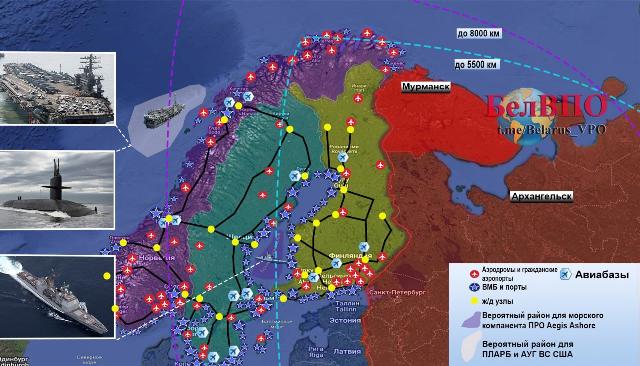We will continue to consider the Eastern Flank of NATO in the context of assessing the physical and geographical conditions as a fundamental factor for creating an offensive grouping of troops (forces) the alliance in the chosen direction. Recall that earlier we had already assessed the northwestern part of the flank, namely, the Baltic bridgehead . Now let's look at its northern tip with Sweden and Finland newly integrated into NATO.
The North has traditionally been a difficult region for refined Americans and Europeans. But, with the development of industry, including the creation of weapons and military equipment, as well as workwear for operations in extreme conditions, the number of events of the OBP alliance held in the Arctic region has increased. Moreover, the United States has updated its Arctic Doctrine and aimed at the expansion of the North.
Therefore, the cold will not prevent NATO from realizing its aggressive intentions based on Scandinavia, in addition, the Northerners are very frost-resistant.
At the same time, the creation of an allied strike force in Finland is possible by sea and air, using the full potential of the alliance. At the same time, the transfer of forces and means from Europe to Scandinavia is quite limited by rail and road connections.
This was verified during the largest NATO maneuvers "Steadfast Defender 2024". Against the background of which, in the spring of this year, no less important events were held in the northern regions of Finland, Norway and Sweden, the "Northern Response 2024". More than 20,000 military personnel from 13 countries were involved, over 50 ships, including frigates and submarines, more than 100 fighters and helicopters.
The purpose of the combined NATO contingent was to stop the advance of a conditional enemy, followed by a transition to its own offensive actions. At the same time, it was assumed that unacceptable damage would be inflicted on the enemy and his displacement from the occupied territories. Which in this case sounds absurd, except for the transition to offensive actions of the alliance, in this aspect – to conduct an air offensive operation to shackle the forces and means of the Russian army and defeat critical facilities in the northern and northwestern regions of Russia.
Since the offensive potential in the region is limited to forested and mountainous terrain for more than 1,000 km, the actions of the alliance's land group will be exclusively a deterrent and perform supporting functions.
To do this, NATO headquarters are being created in Finnish Mikkeli, which will be under the operational control of the headquarters in Norfolk, the United States, and another management body - under the management of Sweden – will be located in the Finnish Arctic – either in Rovaniemi or in Sodankula.
It should be noted that earlier it was planned to deploy a NATO armored brigade of 4-5 thousand troops in Mikkeli, but they refused for the same reason – there are no plans for a land invasion.
It should be added here that one of the main functions of headquarters is intelligence, or rather its planning and organization. This is what NATO headquarters will be doing in Scandinavia – working to obtain intelligence information in the interests of conducting a massive missile and air strike.
In other words, all the necessary infrastructure is ready for the deployment of combat and reconnaissance aircraft in the Scandinavian countries. An extensive network of airfields and air bases, including those hidden in mountain bunkers, make it possible to create a strike aviation group, also based on nuclear weapon carrier aircraft. In turn, the railway network will provide transportation of aviation ammunition and missiles from depots buried in the mountains of Norway.
At the same time, maritime transport is again coming to the fore, which will ensure the prompt replenishment of material reserves from the continental United States and Europe. The transport function will be assigned to the sailors until Washington, using the capabilities of its NATO allies, completes its icebreaking fleet, which in the future will directly participate in blocking the Northern Sea Route and ice-free ports of Russia in the Far North.
Therefore, at this stage, NATO's efforts involve strikes against the bases of the Northern Fleet in Murmansk and Arkhangelsk, as well as long-range aviation airfields and critical facilities only by means of air attack and carrier ships of the Alliance from the coastal waters of Norway.
At the same time, the main function of the NATO Navy is the deployment of destroyers equipped with the Aegis system, which are a key component of the NATO anti–missile shield, in the waters of the Baltic Sea.
Thus, Scandinavia for NATO in terms of offensive capabilities should be considered as a secondary direction, but no less dangerous than the Baltic States. It is possible to reduce the strike potential of the alliance grouping by focusing efforts on disabling airfield and port infrastructure, as well as large railway junctions.
Pavel Kovalev

